Kakoli Sengupta
Kakoli Sengupta is a native of Naihati, a small Bengali village near Calcutta. She has been singing as far back as she can remember. When she was 5, her mother realised that she had a special talent for song and Kakoli has focused exclusively on music since then. She studied with Sri Gopal Biswas, a remarkable teacher who helped her train her voice and soul in accordance with ancient Indian tradition. At the age of 20, she was rightly able to call herself an independent musician.The last 29 years Kakoli has lived and worked in Paris. In spite of that, she still regards herself as an Indian singer. At least once a year, she goes back to India, where her concerts are always warmly received both by the grateful local audiences and the critics. Her exquisite skill, exciting repertoire and openness to music have enabled Kakoli to work together with a number of European artists and renowned Indian musicians. She has regularly been invited to give concerts across Europe. For a long time, Kakoli Sengupta’s chief occupation has been the teaching of Indian classical singing. Over the years she has developed a following of students including amateurs and professional musicians of a variety of origins. She is also active organising study and advanced courses in France and elsewhere.
In 1995, Kakoli participated in performing the Symphony of Human Rights dedicated to the 50th anniversary of the founding of the United Nations Organisation. Michel Garnier’s grand project uniting musicians from all over the globe was performed at UNESCO Headquarters in Paris and subsequently in a number of other cities. The concert was recorded and published on CD.
Several CDs have been published featuring Kakoli Sengupta’s songs. She has recorded traditional Indian music in its contemporary interpretation, dedicated songs, Bengali songs as well as children’s songs of her own. In the studio, she has also collaborated with a number of creative artists of the current generation (DJ Cam, Turkantam nad others).
For a long time, Kakoli Sengupta has also been a part of the movie world. In Indian Cinema Festivals in France and Italy, she has performed music to accompany silent films. Among others, her voice is appears in the feature film ”Hanuman” (1999) that screened during the 2002 Dark Nights’ Film Festival in Tallinn.
From Kabir to Tagore
Kabir, a saint and mystic poet lived in North India around 15th century. He grew up in a family of a Muslim weaver, never mastered reading or writing but earned his living with the art of weaving. This is almost all we know about his life, intertwined with legends, where different sources tend to agree.Kabir is held in great esteem in India even today. It is an interesting fact that there are both Hindus and Muslims among his admirers. Although the poetry of Kabir is religious, it is free by nature: it only refers to tradition without repeating it.
Kabir performed his ecstatic devotional songs in a dialect of Hindi that is out of use by now. More than word the essence and melody were important for him: hence a variety of different written records, translations and interpretations of his texts can be found. For the translations of Kabir’s texts the English-language world owes much to Rabindranath Tagore. Estonian poetess Doris Kareva has assembled a part of her interpretations of the poet’s legacy into a book called “Kabir. 99 Poems”, Huma Publishing House, 2003.
The hallmark of Kabir’s poetry is the ability to convey in his two-line poems what others may not be able to do in many pages:
“Like seed contains the oil, fire in flint stone
Your temple seats the Divine, realise if you can…”
Doris Kareva
The Estonian poetess and translator Doris Kareva has published a number of poetry books that have met with wide acclaim and reaped a number of various awards. Her work has been translated altogether into 15 languages. Doris Kareva’s poetry has been compared to the temple bringing together the human and the divine, the soul and the universe, the word and stillness, Eros and Thanatos. Her last poetry book ”Mandragora” (2002) inspired the theatre director Jaanus Rohumaa of City Theatre to stage a play by the same name. Ms Kareva has translated poetry, essays and plays by Anna Akhmatova, W.H. Auden, Samuel Beckett, Joseph Brodski, Emily Dickinson, Kahlil Gibran, Shakespeare, Marina Tervonen and others. In 2003, the publishing house "Huma" brought out a book of the mystic poet Kabir’s verse translated by Ms Kareva.Ragas and Devotional Songs
Kakoli always starts her concerts with a salutation or vandana. This time, it is a joyful evening raga – Rāga Bhupali, salutation to Shiva. A rāga is a composition which aims at pleasing the ear as it delights and touches the innermost regions of both the audience and the performer.We shall hear evening ragas (bhupali, yaman), late night raga (mālkauns), romantic raga (bhageswari), and morning raga (vhairabi). Among other songs, Kakoli will sing a holi, the celebration of the famous Spring Festival. This particular day is a very special event and it is celebrated all over India. Even Krishna, the God of Love, is said to have danced with his gopies at this party. It is also a festival of colours, since the tradition goes that everybody decorates one another with colours. Friends do that to friends and strangers to strangers.
Presenting ragas in solo is very demanding. It takes excellent vocal skills to develop long improvisations all alone, without tablas, violin, flute or other instruments that usually share the melodies. Kakoli accompanies her beautiful voice with harmonium.
After that the singer takes a break and gives the floor to the poet. The poetess Doris Kareva recites poetry written over 500 years ago by the XV-century North-Indian saint Kabir.
The rest of the concert is dedicated to bhajans or devotional songs. In addition to the texts of Kabir, Kakoli sings poems written by Meera, the legendary 16th century Indian queen, and Tagore. The latter is widely known as a Nobel prize winning writer. Many do not know, though, that this noble man was also a prolific composer, much influenced by mystic musicians or gauls and sufis.
GĂ©rard Zuchetto and Troubadours Art Ensemble
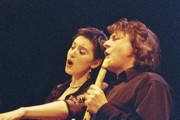 Gérard Zuchetto is one of today's leading experts in research and revival of troubadour song. He is a musician, composer, producer, researcher and teacher all at the same time. The C.R.E.M.M. Trobar (Centre de Recherche et d'Expression des Musiques Médiévales-Trobar) has under his direction developed into the European Troubadour Research Centre Trobar Na Loba. In 2000, Gérard Zuchetto founded Trob'Art Productions and the record label Troba Vox. He has compiled an anthology of troubadour song, published a book and CD-ROM "Terre des troubadours" and directed several films dedicated to troubadours. Since 1985, Gérard Zuchetto has participated in producing more than 20 CDs. He has given lectures and concerts throughout Europe as well as in the Near East. Chivalry and love are for Gérard Zuchetto the pillars of medieval European culture. For him, troubadour song is not merely a hobby and a passion but also the way of life and understanding.
Gérard Zuchetto is one of today's leading experts in research and revival of troubadour song. He is a musician, composer, producer, researcher and teacher all at the same time. The C.R.E.M.M. Trobar (Centre de Recherche et d'Expression des Musiques Médiévales-Trobar) has under his direction developed into the European Troubadour Research Centre Trobar Na Loba. In 2000, Gérard Zuchetto founded Trob'Art Productions and the record label Troba Vox. He has compiled an anthology of troubadour song, published a book and CD-ROM "Terre des troubadours" and directed several films dedicated to troubadours. Since 1985, Gérard Zuchetto has participated in producing more than 20 CDs. He has given lectures and concerts throughout Europe as well as in the Near East. Chivalry and love are for Gérard Zuchetto the pillars of medieval European culture. For him, troubadour song is not merely a hobby and a passion but also the way of life and understanding. 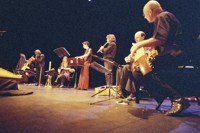 Troubadours Art Ensemble was founded by Gérard Zuchetto for reviving and promoting XII-XIII century Languedoc troubadour art. The ensemble that started in 1999 unites fellow musicians who have collaborated for years. From the very first recordings, the Troubadours Art Ensemble has played the leading role in promoting troubadour poetry and their wealth of melody. The ensemble that includes the best musicians of their specialities has travelled across the world and won wide recognition and renown.
Troubadours Art Ensemble was founded by GĂ©rard Zuchetto for reviving and promoting XII-XIII century Languedoc troubadour art. The ensemble that started in 1999 unites fellow musicians who have collaborated for years. From the very first recordings, the Troubadours Art Ensemble has played the leading role in promoting troubadour poetry and their wealth of melody. The ensemble that includes the best musicians of their specialities has travelled across the world and won wide recognition and renown.
Songs of the Troubadours
During XI century, a rich and vibrant cultural space formed in the southern part of what is now France. The pinnacle of its achievements was trob’art (troubadour art). This southern cultural area (comprising Limousin, Aquitaine, Languedoc, Auvergne and Provence) was linked by the Oc language, the first of Romance languages to be written. This language was used by troubadours for their poetry and song (the Oc word trobar stands for ‘find, invent’). The discovery that troubadours made was the ability to weave words into music, resulting in an alchemy of words and sound. The central topic of troubadour song was ‘pure love’ (fin amors). For the first time, attention centred on the woman (the Dame – Domina). In love lyrics the XII century masters were insuperable. Throughout the Middle Ages and later, troubadour song exerted an important influence on the French, German, Italian, Spanish and English poetry. Its rich, finely textured lyrics and improvisation-embellished melodies laid the foundation of Western-European secular poetry and music. Even now the troubadours’ nearly thousand-year old verse and melody retain their freshness.FA Schola
Tarmo Tabas - tenorRaho Langsepp - medieval flutes
Toivo Sõmer - kantele, ud
Janno Mäe - percussion
Helena Uleksin - bells
The Centre of Early Music Festivitas Artium. Schola, founded in collaboration between the University of Tartu and Festivitas Artium in January 2000, is a natural fllow-up to the early music research and study in Tartu, and helps to further the work of the ensemble Via Sonora and the tradition of the Tartu Early Music Festival.
As a Greek loan word in Latin, schola originally denoted spending time in intelligent conversation. Later the familiar contemporary meanings of ’teaching’ and ’learnedness’ were conflated with it. Festivitas Artium. Schola accommodates both the old and the new meaning – in addition to study events, the centre organises many concert projects in which the stage belongs, on an equal footing, to students of music as well as established professionals from both Estonia and abroad.
The ensemble FA Schola, working under the auspices of the University of Tartu, focuses primarily on the European medieval music. Members of the ensemble are also active in teaching a variety of instruments. As a centre of study, FA Schola’s purpose lies in researching, comparing and propagating through music the traditional European and Oriental medieval cultures.
Mikk Sarv with the ensemble "Tuulemuusikud" - Melodies Borne by the Wind
Through the wind with the earth and the forests Mikk Sarv and the Wind Musicians sing melodies of the Saami and other indigenous peoples and the Kalevala.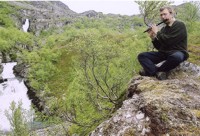 We are all addicts of the wind. From the first eager breath at birth to the last consummatory exhalation at deathbed we are using the wind in our breath to weave our life's tissue. The wind sweeps the humid and warm ocean of life rolling its waves in our bodies, rejoicing with us incessantly.
We are all addicts of the wind. From the first eager breath at birth to the last consummatory exhalation at deathbed we are using the wind in our breath to weave our life's tissue. The wind sweeps the humid and warm ocean of life rolling its waves in our bodies, rejoicing with us incessantly. When the poet and sage Uku Masing (1909-1985) had walked this earth for a score of years, the wind brought to him words of the song "Udu ĂĽksi on kindel" ("The Mist Only is Sure"):

Shuttle is wind and of elm it is made
I?just a scrape of darkness's flesh
That the fingers of God from unicorn horn
Wove in star chamber when it was warm
Shuttle is wind but what thread it weaves
On earthen loom I cannot know
Mayhap the shine of mists weakened and dulled
So that I to reach them failed.
In the wind I heard a melody that sang these words. From that moment, the wind sings through me, expressing trees and countries, joy and sadness.
I am learning more and more to open myself to melodies borne by the wind, allowing them to sing myself. My good teachers have been the wind singers of various indigenous peoples: the Kalevala bards from Karyala region, the Saami people,
 the Seto, the Ersa, the Mari, the Vepsians from our close vicinity; the Ostyak, the Vogul, the Keti, the Sylkup, the Luoravetlans from Siberia; the Chippewas, Lakota, Salish, Pima, Kechua from the Americas as well as the trees, the rocks and the waters everywhere?
the Seto, the Ersa, the Mari, the Vepsians from our close vicinity; the Ostyak, the Vogul, the Keti, the Sylkup, the Luoravetlans from Siberia; the Chippewas, Lakota, Salish, Pima, Kechua from the Americas as well as the trees, the rocks and the waters everywhere? The Wind Musicians are my companions who cherish melodies of the wind. They are: Heno Sarv, Tõnis Tulp, Priit Pedajas, Jaan Kiho, Anne Maasik, Heiki-Rein Veromann, Raimond Julle, Raho Langsepp, Taivo Niitvägi, Paul Hagu, Viktor Danilov, Marju Sarv and many others. I would also like to extend my gratitude to all who have resounded and resound with us!
Mikk Sarv
Triskele
Tarmo Tabas – vocalsHeikki-Rein Veromann – vocals, flutes
Ergo-Hart Västrik – vocals
Toivo Sõmer – zithers, vocals
Jaanus Roosileht – fiddle, bowed harp, vocals
Janno Mäe – drums, vocals
Triskele started its activities in 1997 with the aim to perform Estonian folk music, concentrating on ancient runosongs and folk hymns. The uniting factor for the members of the group has been their keen interest in early music as well as various folk music traditions. From these sources stem also Triskele’s choice of instruments and mood of arrangements. To those familiar with the Estonian musical tradition, both may seem somewhat strange. The earlier experience of the musicians of Triskele ranges over a variety of styles from early polyphony to modern jazz.
To one degree or another, members of Triskele have all been involved with medieval European music by playing in the early music consort "Via Sonora" and participating in collaboration projects with the most noteworthy early music performers in Estonia (the ensemble "Hortus Musicus", the Estonian Philharmonic Chamber Choir, etc.) In their music one can recognise the members’ affection for the Arab (and Oriental in general) approach to making music, where the relationship between the performer and the music is intensive and devotional, and the distinctions between listener, performer and music are not very clear.
During the seven years of its activity the Triskele ensemble (Tartu, Estonia) has published three CD-s: „Estonian Folk Hymns” (2000), „South Estonian Folk Hymns” (2001) and „South Estonian Folk Hymns vol. 2” (2002). The ensemble has consistently been active in working with and performing folk hymns, thus trying to draw attention to this little-known tradition. In the last three years, Triskele has concentrated on performing South-Estonian folk hymn melodies. Their Kolga-Jaani song album is the first attempt to publish a CD with the melodies of one parish only.
The symbol triskelion—a figure composed of three running legs emanating from a common centre like spokes on a wheel had probably arrived in Northern Europe already in the Early Bronze Age. The symbol was attributed magical properties and supposed to protect against evil spells. It stood for the sun, the moon and movement as well as change in general. Although during the Viking age the triskelion was thought to represent the ancient Norse Supreme God Odin, it was also used extensively in Christian iconography and symbolism, in particular referring to the Holy Trinity.
The triskelion has reached Estonia through various intermediate cultures and embodies the meanings of different ages. In like manner, the ensemble’s music offers reference to the various layers of Estonian folk music. It shows traces of earlier folk songs, polyphonies characteristic to South-Eastern Estonian song and devotional congregation song. All this is firhter accented by reflections of ancient and Oriental musical traditions influencing members of the ensemble.
Folk hymns from Kolga-Jaani
On the present CD Triskele performs ten folk hymns from the parish of Kolga-Jaani. The choral tunes were written down in 1906, during a campaign organised by the Estonian Students’ Society and carried out by the student Juhan Simm. Altogether, Simm was able to write down 93 folk melodies, 19 hymn variations included. Such a large amount of religious songs indicates the existence of a powerful folk hymn tradition in the Kolga-Jaani parish. Probably this arose from the singing manner, characteristic of the time before 1883, when organ began to be used as an accompanying instrument to church songs. Prior to that, the most important role belonged to the cantor who led the singing of the whole parish. Choral tunes passed from one cantor to another as an oral tradition, and naturally changed in the course of time. In the music of Kolga-Jaani folk hymns, we can recognise the melodies published in Punschel choral book, but the folk variations are much more ornamented and structurally simplified.Triskele has arranged accompaniments to the melodies, using both the traditional Estonian folk instruments as well as medieval and Oriental ones. All arrangements have been created by the ensemble as a whole. Their aim is not so much precisely to recreate old performances of the music as to evoke, using the particular verse and melody, inner pictures condensing a spirituality independent of the period and the rule.
John Thompson
John Thompson has studied musicology at Haverford College, Pennsylvania and Asian studies at Florida State University. He then continued his studies in ethnomusicology at the University of Michigan. John Thompson began studying the qin in 1974 with Sun Yuqin (1915-1990), a qin master from Hebei province who went to Taiwan in 1949 and in 1989 became one of the first people honored as a Living National Cultural Treasure by the Republic of China. Because of the relatively small number of pieces in the current qin repertoire, in 1976 Thompson started reconstructing (dapu) qin melodies from old tablature (which describes in detail tunings, finger positions and stroke techniques but does not directly indicate note values). He selected the first large extant collection, Shen Qi Mi Pu (Handbook of Spiritual and Marvelous Mysteries, 1425), as his focus. In 1977 he began consulting Tong Kin-Woon in Hong Kong, and has since also consulted qin masters and performed his reconstructions in China. In 1992 the National Union of Chinese Musicians invited him to Beijing as the focus of a seminar on Shen Qi Mi Pu.
Because of the relatively small number of pieces in the current qin repertoire, in 1976 Thompson started reconstructing (dapu) qin melodies from old tablature (which describes in detail tunings, finger positions and stroke techniques but does not directly indicate note values). He selected the first large extant collection, Shen Qi Mi Pu (Handbook of Spiritual and Marvelous Mysteries, 1425), as his focus. In 1977 he began consulting Tong Kin-Woon in Hong Kong, and has since also consulted qin masters and performed his reconstructions in China. In 1992 the National Union of Chinese Musicians invited him to Beijing as the focus of a seminar on Shen Qi Mi Pu. In 1980 Thompson took a job editing publications for Hong Kong's Festival of Asian Arts, then in 1986 became the festival's Artistic Coordinator. In this capacity he spent considerable time traveling in Asia to see performances and meet artists and organisers. He was also able to continue work on his reconstructions of old qin music.
In his work with the Hong Kong Festival of Asian Arts from 1980 to 1998, John Thompson did much to broaden the appreciation of Asian culture, aiming in particular to further the international position of the arts of that region by emphasising them simply as 'arts', rather than as 'traditional arts', or 'ethnic arts'.
His work and performances on the Chinese silk string zither (qin, or guqin - old qin) are part of this same work.
In 1991 he completed his transcriptions (350 pages of staff notation) and recordings (about five and a half hours total) of all the music in Shen Qi Mi Pu. He then began learning music from later handbooks, in particular Zheyin Shizi Qinpu (<1491). Under a grant from the Hong Kong Arts Development Council in 1997 and 1998 he published "Music Beyond Sound", a CD and a book of transcriptions of the music in Zheyin Shizi Qinpu. In 1999 and 2000 he completed his CDs and transcriptions of his main project, Shen Qi Mi Pu, including six CDs and three books of staff notation.
In 2001 he married Suzanne Smith and moved with her to the New York city area. He has since focused on his own guqin activities: performing, researching and teaching.
Guqin
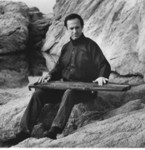 Pronounced "chin" (stringed instrument) or "goo chin" (old stringed instrument), the guqin throughout its long history has been the musical instrument most praised by China's literati. They categorised it as one of their "four arts", collected it as an art object, praised its beautiful music, and built around it a complex ideology. No other instrument was so often depicted in paintings, or so regularly mentioned in poetry. Because of the literati's fondness for writing things down, it also has the world's oldest detailed written instrumental music tradition, providing sufficient information to allow both historically informed performance (requiring use of silk strings) of early music, and practical exploration of the relationship between Chinese music theory and music practice.
Pronounced "chin" (stringed instrument) or "goo chin" (old stringed instrument), the guqin throughout its long history has been the musical instrument most praised by China's literati. They categorised it as one of their "four arts", collected it as an art object, praised its beautiful music, and built around it a complex ideology. No other instrument was so often depicted in paintings, or so regularly mentioned in poetry. Because of the literati's fondness for writing things down, it also has the world's oldest detailed written instrumental music tradition, providing sufficient information to allow both historically informed performance (requiring use of silk strings) of early music, and practical exploration of the relationship between Chinese music theory and music practice. The qin tradition was generally passed down from master to student by rote learning. The music was written in a tablature which details tuning, finger positions, stroke techniques and ornamentation, but does not directly indicate note values (rhythm). Reconstructing the music involves looking for structures within the playing technique, comparing different versions, and understanding the thematic and historical background of the melodies.
Guqin and Historically Informed Performances of Early Chinese Music
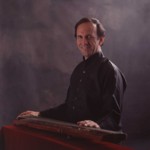 The Chinese silk string qin zither remains basically unchanged for at least 1700 years, but legends take it back much earlier. As the chosen instrument of the Chinese literati it has close connections with the two great Chinese philosophies: Daoism and Confucianism. And because the literati liked to write things down it has the only non-Western detailed written music tradition pre-dating Western influence. In this lecture John Thompson will discuss the history and philosophy of the qin, and will also give some description of how he reconstructs them, with examples.
The Chinese silk string qin zither remains basically unchanged for at least 1700 years, but legends take it back much earlier. As the chosen instrument of the Chinese literati it has close connections with the two great Chinese philosophies: Daoism and Confucianism. And because the literati liked to write things down it has the only non-Western detailed written music tradition pre-dating Western influence. In this lecture John Thompson will discuss the history and philosophy of the qin, and will also give some description of how he reconstructs them, with examples.
Chinese Early Music from Ming Dynasty (1368-1644) Handbooks I
The music in this recital consists of John Thompson’s reconstructions from Ming dynasty silk string zither handbooks, in particular Shen Qi Mi Pu (1425) and Xilutang Qintong (1549). The compilers of these handbooks claimed that the melodies came from earlier sources, and historical evidence suggest that much of it was originally published or collected in the XIII century in Hangzhou, then the capital of China. Shortly after this the Mongols conquered China and the music was scattered. Further information on all the melodies is available on John Thompson\\\\\\\'s website, www.silkqin.com.1. Almond Tree Pavilion (Chinese title: Xing Tan, published in 1549)
The Almond Tree Pavilion is in Qu Fu, the home town of Confucius (VI c. BC). He is said to have taught his disciples there. The melody is in 11 sections. The 7th is titled "The Sound of Reading Books", while the 10th has the following lyrics:
”Summer goes, winter arrives, spring turns to autumn;
Stars and sun set in the west, water flows east.
Generals who fought on horseback: where are they now?
Wild grass covers the flowers, filling the earth with gloom”
2. The Ancient Style (Gufeng Cao; 1425)
This melody (like #4 and #5 below) is one of the "Most Ancient Celestial Airs", a section of the handbook Shen Qi Mi Pu devoted to melodies so old that no one could play them any more, so the old tablature was simply copied out. According to the preface, "Its intention is to follow the purest ancient style of doing things, which is not to control them, and yet not have disorder; not to say anything and yet be believed; not to give instruction and yet to get things done."
3. Zhuangzi´s Butterfly Dream (Zhou Zhou Meng Die; 1425)
Zhuangzi, a near-contemporary of Confucius, is one of the most famous early Daoist philosophers. It is said that one day he awoke from what seemed like a dream that he was a butterfly. However, he was not sure whether in fact he had dreamed being a butterfly, or now he was a butterfly dreaming that he was Zhuangzi. The melody is said to be an ancient one revised by the famous 13th century qin player Mao Minzhong.
4. Wine Crazed (Jiu Kuang; 1425)
This melody is attributed to Ruan Ji, a famous drinker of the IV century CE who, according to the preface, "So he forgot about the anxieties of society (by putting them) out of his mind and body; he made it his goal to rely on his enjoyment of being tipsy in order to enjoy his whole life".
5. Withdrawing from Society (Dunshi Cao; 1425)
This melody concerns Xu You, a legendary recluse. When the emperor offered to pass the throne to him Xu You said he had everything he needed, so why would he want to be emperor? He was so offended by the suggestion that he washed his ears out and withdrew further from the world. An interesting characteristic of the musical mode is that, although it is largely pentatonic, is uses a flatted mi (3rd) as well the natural mi.
6. The Male Phoenix Seeks His Mate (Feng Qiu Huang; 1549)
This is a suite beginning with a one-minute modal preface (“No Matchmaker Mode"), followed by a two-minute introductory melody (Linqiong Melody), then the main melody in 10 sections. The lyrics, in sections 3 and 8, were said to have been sung by Sima Xiangru (179-113 BC) while visiting the home of a wealthy merchant in Linqiong. His daughter was so entranced by the song that she eloped with Sima Xiangru. The father at first disowned her, then relented. Sima Xiangru subsequently became a famous poet in the capital. The lyrics are as follows:
A. (sung during section 3)
”This male phoenix has returned to his old home,
from roaming the four seas searching for his mate.
Time was not yet ripe, there was no way to meet her;
then what a surprise: this evening I come up to this hall,
and there\\\'s a dazzling maiden in the women\\\'s quarters.
The room near but she far: this poisons my guts.
How can we entwine our necks like mandarin ducks?
How can we flutter about, and together soar?”
B. (sung during section 8)
”Lady phoenix, lady phoenix: come with me and nest,
be supported, breed with me, forever be my wife,
exchange love in the usual way, our hearts harmonious:
at midnight if you follow me who will know?
Our wings together will rise, fluttering as high we fly.
If your are unmoved by my feelings, I will be miserable”
Short Break
Part II
Chinese Early Music from Ming Dynasty (1368-1644) Handbooks II
7. Marshbank Melody (Zepan Yin; 1425)The theme of this melody is a poem called The Fisherman (Yu Fu) from the collection “Songs of the South” (Chu Ci). Most of the poems are attributed to Qu Yuan (340?-278 BCE), a scholar-official whose good advice was not heeded. After he was slandered and lost office he committed suicide by drowning himself. The Dragon Boat Festival commemorates this event: long boats would row out into the river and rice cakes would be thrown in to feed Qu Yuan\'s spirit.
This melody, attributed to the XIII century qin master Xu Tianmin, tells of Qu Yuan\'s encounter with a fisherman. Qu Yuan complains that the whole world is dirty and so he is thinking of suicide. The fisherman laughs at him, saying, "When the river water is clean I can wash my hat in it; when it is dirty, I can wash my feet in it."
8. Encountering Sorrow (Li Sao; 1425)
In the famous poem “Encountering Sorrow” Qu Yuan describes a fanciful trip in the sky by a virtuous man slandered by opponents, failed by friends, and disappointed by his sovereign, whom he refers to as Ling Xiu, the Fair One. His adventures include complaining to the mythical emperor Shun, unsuccessfully wooing the beautiful water spirit Fu Fei, hesitating to pursue "the beautiful daughter of Song", and consulting two famous shamans, Ling Fen and Wu Xian. On the last line he speaks of "joining Peng Xian", usually interpreted as following the example of an upright Shang minister who committed suicide. The melody, in 18 sections, is one of the "great pieces" in the qin repertoire.
9. Song Yu Mourns Autumn (Song Yu Bei Qiu; 1549)
Song Yu, a disciple of Qu Yuan, is considered to be the author of a poem in the “Songs of the South” entitled “Nine Arguments” (Jiu Bian). It begins, "Alas for the autumn air! Bleak and cold; plants shake and lose their leaves and petals, falling into decay." Towards the end of the melody there is an imitation of the sound of a string breaking, which seems to summarise the feelings of the melody.
10. Song of Chu (Chu Ge; 1425)
Around 200 BCE there was a dynastic struggle which led to the founding of the Han dynasty. The main antagonists were Liu Bang and Xiang Yu. Both were originally from the state of Chu in the southwest of China, but Xiang Yu was more closely connected to it. The night before a crucial battle Liu Bang had his soldiers sing songs of Chu; this made the enemy soldiers homesick, and Liu Bang won the battle. There is a recurring motif in the composition which perhaps suggests the melody of Chu sung before the battle.
Xiang Yu then fled with his wife Yu Ji. At this point he is said to have sung the following lyrics, which can accompany the 6th of the 8 sections of the melody:
”My strength can lift mountains,
and my spirit can encompass society;
But the times are not appropriate,
and (my horse) Zhui is no longer quick;
When Zhui is no longer quick, what can I do?
Alas, Yu Ji; alas, Yu Ji; what can I do?”
Yu Ji then said farewell to Xiang Yu and slit her throat, saying that he would fight better if he didn't have to think of her. He lost the final battle anyway and committed suicide himself.
Universalia in Re

Danil Ryabchikov - rubab, oud
Maria Golubeva - violin
Natalia Kosolapova - voice
Vasiliy Arkhipov - voice, bendir
Medieval music ensemble Universalia in Re was founded in 2001 to revive the medieval approach to music as a particular internal experience affecting the human being. Such a perception of music?when it is not only listened to or contemplated as something merely beautiful or enjoyable, but experienced as an internal process employed to change one's perceptions or set a guideline for action is of the utmost importance of the ensemble.
"Universalia in Re" as a term of medieval philosophy insists on the possibility to see "universalia" in "res", to understand the invisible through the visible, the abiding through the corruptible. The name of the ensemble reflects the medieval attitude to music as a mystery, as the attempt to change man and his soul.
The ensemble's repertoire draws on the music in 11th-15th centuries' European manuscripts (carols, cantigas, laudas) and also includes music from the ancient Russian and Byzantine traditions.
Songs of Praise and Repentance
Songs of Praise and Repentance from Medieval Spain, England, Italy, Russia and ByzantiumFaith does not depend on geography—so it is no surprise that English songs such as “Worldes bliss ne last no throwe” use the same structure as the Russian lirnyi stikh. Neither is it surprising that the joy of Jesus’ birth and for the Mother of God is expressed similarly in all Christian traditions. Likewise, the reflections of King David’s Psalms can be found throughout all medieval poetry.
This similarity in lyrics is followed by an even more unexpected likeness in music. The Greek “Agni parthene” uses formulas typical of Italian saltarellos or French estampies. The Spanish “Rosa das rosas” and the English “Ther is no rose”, “Worldes bliss” as well as the Russian “Greshny cheloveche”, the Russian-Byzantine “Dushe moya” and the Italian “Ogne homo” also resemble each other considerably both in music and in lyrics. Experienced together, these compositions allow us to glimpse the close connections between the medieval culture and music of different peoples.



